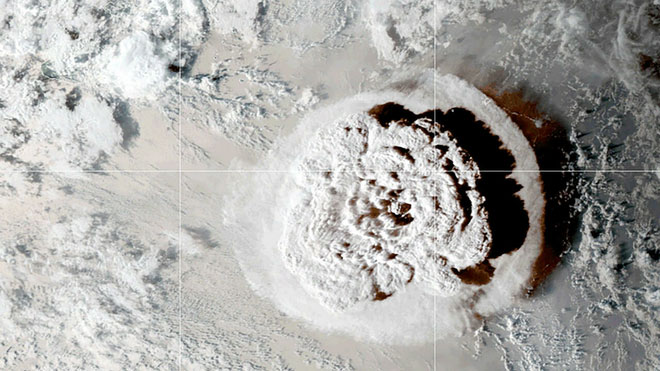NASA scientists have reported that the volcanic eruption in Tonga on January 15 released an explosive force far exceeding that of the atomic bomb dropped on Hiroshima, Japan, in 1945.
“We believe that the energy released from the volcanic eruption is equivalent to 5-30 million tons of TNT explosives,” said scientist Jim Garvin from NASA in a press release.
According to the agency, the eruption in Tonga had a destructive power hundreds of times greater than the atomic bomb dropped by the United States on Hiroshima in August 1945, as reported by AFP.
This atomic bomb was estimated to have a destructive power equivalent to 15,000 tons of TNT.

The volcanic eruption covered the island nation of Tonga with a thick layer of ash. (Photo: AFP).
On January 15, the Hunga Tonga-Hunga Ha’apai volcano launched debris into the atmosphere reaching heights of 40 kilometers and triggered large tsunami waves, according to NASA’s Earth Observatory.
The agency also reported that the eruption had “wiped out” the volcanic island located about 65 kilometers north of the capital, Nuku’alofa.
The island nation, with a population of approximately 100,000 people, was blanketed by ash, drinking water was contaminated, and crops were destroyed. At least two villages were completely obliterated.
Authorities in Peru also declared an environmental disaster after waves struck an oil tanker near the capital, Lima, causing a large oil spill along the coast.
Mary Lyn Fonua, a local journalist, stated that the people of Tonga are still grappling with the scale of the disaster.
“It surpasses anything anyone here has ever experienced,” she told AFP. “The shockwaves from the eruption have disrupted our brains. Now, we are just beginning to return to normal.”
Ms. Fonua also mentioned that the fine gray ash covering everything could raise concerns about long-term health issues.
“The (gray ash) is everywhere. It irritates the eyes and causes sores at the corners of the mouth. Everyone’s nails are black,” she said.


















































